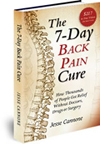
Back pain relief in 3 steps
Fighting back pain but not seeing results?
Maybe you’re missing something.
After helping thousands of back pain sufferers get relief one thing has become crystal-clear: you usually need to address more than one area of your health to get total and lasting back pain relief.
In fact, there’s three major areas that must be considered for optimal health: body, mind, and diet. Take care of all three and you’ll have success. Ignore just one and you may never get back to 100%.
Step 1: Your Body
Most of us were born with a fairly well-balanced body. And very little pain.
But as life goes on we seem to get more and more of those aches and pains that are just a “part of growing older.”
Only, it’s not so much that we’re getting older. We’re getting more and more out of balance.
In our daily activities, we all tend to favor one side or repeat the same movements over and over again. When some muscles are worked much more than others, they naturally grow stronger while opposing less-used muscles grow weaker resulting in muscle imbalances.
The more we repeat those same activities the larger the impact. Here’s some ways to minimize that impact:
Posture and Stretching
Hours sitting hunched over a computer, steering wheel, or video game adds pressure to your spine.
Your chest and neck muscles tighten while your upper back and shoulder muscles weaken. The result of this tug of war between strong and weak muscles is neck and back pain.
Constant sitting tightens your hip flexors while your stomach, hamstring, and buttock muscles become weak from underuse.
- On long airplane trips, get up, stretch, twist, and bend to refresh your muscles. Even 15 seconds of stretching can help.
- Take frequent breaks at work to stretch out a tight lower back. While sitting, lean forward to reach toes. Hold for several seconds and repeat.
- Do full squats. Stay in the squat position for several seconds with your feet flat on the floor. Repeat a few times. Hold onto the back of your chair for support if needed.
Exercise and Sports
A daily exercise routine is important to your health, but is your routine strengthening some muscles while leaving opposing muscles dangerously weak?
Sports such as golf, tennis and baseball which use one side of your body more than the other or require unnatural postures are notorious for creating muscle imbalances. You need variety in your exercise to prevent muscle imbalances that cause back pain.
If you’re already in pain due to long-established muscle imbalances, it will take a focused effort to restore your body to a neutral state. That’s where Muscle Balance Therapyâ„¢ can help.
Step 2: Your Mind
Your back pain may have an emotional origin because the mind and body are deeply connected.
Your thoughts can trigger physical reactions, including fluctuations in blood pressure, oxygen levels, and breathing rates.
Stress, Anxiety & Depression
Frequent stress, anxiety, depression, and other negative emotions can lead to physical symptoms of pain and discomfort. Among other negative effects, during periods of stress your muscles tighten, constricting blood vessels and inhibiting circulation.
As impaired circulation continues, toxins and other waste products build up in your body tissues, making these areas ripe for painful trigger points. These tiny muscle knots are behind as much as 75% of all pain, often felt far from the actual trigger point itself.
Your plan to prevent new or recurring back pain from trigger points should include a strategy to combat negative emotions leading to stress and anxiety. Here’s a few techniques that can help:
- Massage – Studies show massage not only provide physical benefits, it’s also an effective way to reduce anxiety and depression associated with chronic pain.
- Exercise — You already know exercise increases your energy levels, burns calories, and can help you lose weight, which can combat some causes of stress and depression already. But exercise also causes your body to release natural feel-good endorphins, an instant emotional pick-me-up.
- Meditiation – If you haven’t tried meditation, you should consider it. As little as 10 minutes being still, breathing deep, and centering your thoughts has been shown to quiet both mind and body after a stressful day, or prepare yourself for the new day to come.
Step 3: Your Diet
Your very survival depends on food and water.
The water you drink cleans out toxins, hydrates tissues and organs, and regulates your body temperature.
Water also provides the fluid necessary for the discs between your vertebrae to cushion every move in your back. Fail to drink enough fluids, preferably water, and your body has a harder time replenishing the fluid squeezed out of these discs day after day increasing the likelihood of a herniated disc and back pain.
Unless you already drink water like a fish, you know what to do here. Drink more water.
Watch Out for Inflammatory Foods
Begin to think of foods in terms of their ability to enhance or reduce pain. Some foods make your body more sensitive to pain.
Are you eating foods your body will break down quickly and store as fat? Is your diet made up of processed foods, baked goods, fruit juice, soda, sweetened cereals, and fast food?
I doubt you’d be surprised to hear that a poor diet like this can cause you to gain weight, increasing the strain on your back as your body’s center of gravity is thrown off.
But did you know these foods also produce inflammatory agents that cause back pain? In fact, the same cells that store excess energy as fat also stimulates inflammation in your body.
Until your mid-30s, your body produces a lot of natural anti-inflammatories. They’re called proteolytic enzymes. The problem is once your body stops producing as many of these, your body’s systemic inflammatory response to inflammation-causing foods and other stressors decreases rapidly.
There’s two things you can do. First, improve your eating habits to eat less inflammatory foods and eat more of the foods that fight inflammation. Secondly, you can replace the enzymes your body used to make in abundance with a supplement.
How to Do It All
Body, mind and diet. It sounds so simple until you actually start implementing changes, right?
If you feel a bit overwhelmed, it’s probably because you’re trying to do (or thinking of doing) everything all at the same time. But you don’t have to. Even if you implement just one change per day, or even one change per week, you will be making progress towards your goal of less pain and more healthful living.
If you’d like some help setting up a plan to take you step-by-step through improving your health in all three of these key areas, then why not get a copy of my book? My goal is to transform the way back pain is treated by giving away one million copies of The 7-Day Back Pain Cure.
Inside my book I go into much more detail on how the body, mind and diet are interrelated in your recovery process. More importantly, I help you determine a step-by-step action plan to not just get back pain relief, but improve your life. I hope you’ll ask for your free copy today.

Ask for Your FREE Copy of
The 7-Day Back Pain Cure




I suffer from very bad lower Back-Pain
Also Jointpains in most of my joints